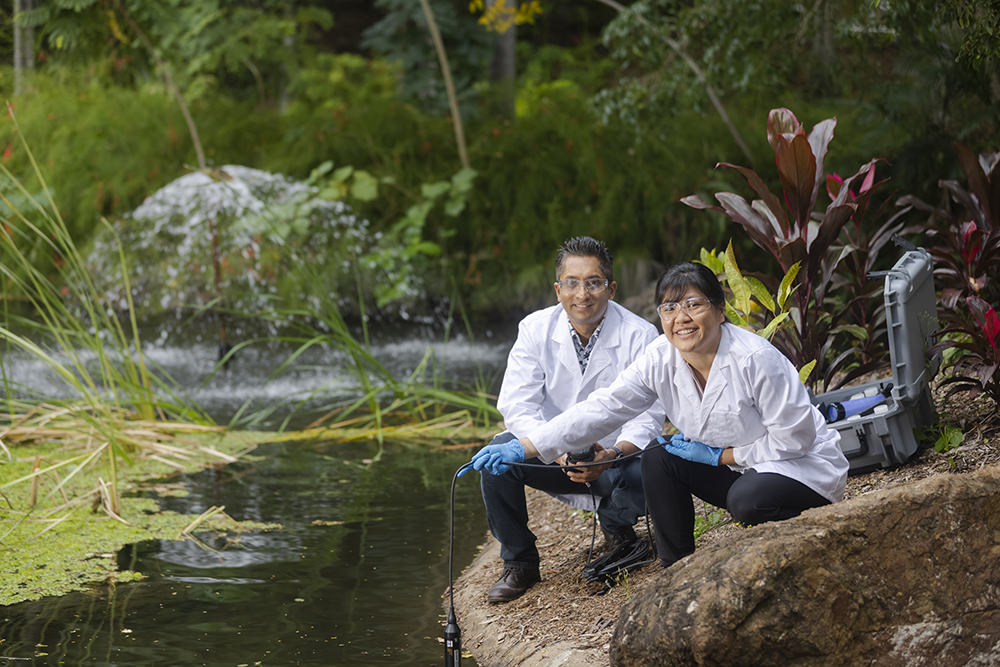DIN has been rated as the most harmful contaminant reaching the Great Barrier Reef but what is it and where does it come from?
The first question is not too difficult. DIN (dissolved inorganic nitrogen) is made up of nitrate, nitrite and ammonium, the most readily available forms of nitrogen for growing plants. Fertilizer nutrients like DIN enter creeks and rivers from many sources and act like fertilisers causing excess growth of plants (eutrophication) causing environmental harm.
Determining where the DIN comes from is more difficult. Understanding the flows of DIN in the environment is crucial to managing water quality and protecting environments like the Reef, but detecting it can be difficult and expensive. This is where new CQUniversity research supported by the WIM Alliance and QWRAP funding aims to bridge the knowledge gap.

The research being undertaken by PhD researcher Fiona Tan and her supervisors Dr Shaneel Chandra and Dr Amie Anastasi, commenced with a review of new technologies for detecting DIN (published recently in Current Opinion in Electrochemistry). The article outlines the deficiencies in currently available tools for assessing DIN and the possibilities for innovation using new electrochemical and nano-technology approaches to improve efficiency, costs and functionality.
Currently DIN measurements are made either by flow injection analysis or the classical laboratory ‘wet chemistry’ methods, both of which are time consuming, chemical reagent heavy, and can suffer from optical interferences associated with spectrophotometry. The electrochemical sensors being investigated in this research project by Ms Tan could instead use reusable and recyclable strips that can be read by a portable instrument – much like a blood glucose meter. Recent advances mean that the technology is now within reach, but research is needed to ensure sensitivity, selectivity, robustness, and stability is achievable.
The project is also investigating ease-of-use, functionality in the field and affordability of novel sensor technology. Current laboratory equipment costs upwards of $400,000 and requires water samples to be collected and transported to the lab for later analysis. Real-time measurements based on spectrophotometric systems are expensive, require skilled personnel and routinely involve replacement of probes every few months.
In contrast, newer electrochemical technologies could be practical for in-field real-time monitoring and capable of transmitting wireless data to a remote monitoring site, building our understanding of the presence of DIN in the environment. It is well established that discharges from the treatment of sewage in GBR catchments contribute less than 5% of the harmful DIN loads impacting the Reef. However, these loads vary from place to place and over time, therefore a better understanding of these flows and the potential sources of nutrients is critical to better managing risks to the Reef and other marine ecosystems. With QWRAP support, the WIM Alliance councils are demonstrating leadership in an area of research that is highly relevant to all marine catchments and sources of nutrient runoff.
This work forms part of the activities of CQUniversity’s Coastal Marine Ecosystems Research Centre (CMERC), that works with industries and communities to develop practical and sustainable solutions to the challenges facing their environments. Ms Tan was also recently selected as CQUniversity’s ambassador to the Royal Australian Chemical Institute (RACI), a role in which she will connect undergraduate and postgraduate students interested in chemistry with potential career opportunities.
Our Success Stories
 Building sustainable service models in remote regional communitiesAugust 6, 2024 - 10:05 am
Building sustainable service models in remote regional communitiesAugust 6, 2024 - 10:05 am South West QWRAP Collaboration Attracts Graduate EngineerJuly 20, 2024 - 9:09 am
South West QWRAP Collaboration Attracts Graduate EngineerJuly 20, 2024 - 9:09 am Spotlight on Mount IsaJune 30, 2024 - 9:00 am
Spotlight on Mount IsaJune 30, 2024 - 9:00 am
Research
 Improving Nitrogen Detection TechnologyFebruary 18, 2022 - 9:00 am
Improving Nitrogen Detection TechnologyFebruary 18, 2022 - 9:00 am Northern Queensland Research on ContaminantsMarch 12, 2021 - 9:00 am
Northern Queensland Research on ContaminantsMarch 12, 2021 - 9:00 am Smoothing out the Infrastructure CliffNovember 22, 2020 - 9:09 am
Smoothing out the Infrastructure CliffNovember 22, 2020 - 9:09 am
Resources
 HR/IR ToolkitApril 19, 2024 - 9:00 am
HR/IR ToolkitApril 19, 2024 - 9:00 am





